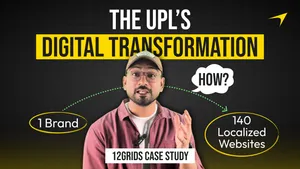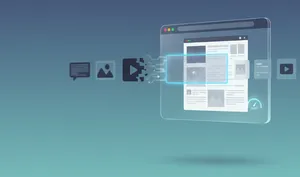How to make a lead generation website for your business
5 mins | 28 Feb 2022

Introduction
Lead generation is extremely important. Hence every marketer out there tries to design and develop his website in such a way that it will generate more and more leads for his business.
For many marketers, their lead-generating efforts focus on digital marketing, which is one of the best strategies for lead generation. However, digital marketing revolves around your website and unfortunately, many websites aren't constructed for lead generation. These websites are slow, thin on content, and unfriendly to mobile users, which makes attracting qualified leads a massive challenge.
For the unversed, who don’t have any idea regarding lead generation. A lead generation website is more than a brochure that focuses on your business.
It should not only educate visitors on what you offer and how your product or service can help them or solve their problems, but it should also provide opportunities for you to collect leads that you can nurture and guide through the sales funnel.
A lead generation website is customer-focused, easy to navigate, and includes obvious calls to action (CTA). A CTA leads visitors and tells them exactly what step you want them to take next. Common CTAs include “call now,” “schedule an appointment,” or “download this information.”
With proper strategy and execution, one can create a strong and effective lead generation engine for their business using their website.
Here are the easy ways to make your website a powerful lead-generation engine.
1. Use attractive CTAs:
CTA’s are responsible for driving your audience to the landing page that drives your business. Your CTA is the most important aspect of your website’s content. However, it can take some time to understand what type of CTA is more successful for your business. To learn how you can craft the best CTA, you’ll have to conduct your own A/B test.
To make matters easy, here are a few points to remember to create powerful CTAs:
- Research and understand which types of CTAs your competitors are using. However, be mindful to only emulate your successful competitors. Not every CTA is worth using.
- Create a list of 10 different CTAs. If you have multiple landing pages, try using a different CTA on each page. Otherwise, you can alternatively use a different CTA every month.
- Keep the conditions the same. If you use a different CTA, don’t alter anything else. The only thing that must change is the CTA. Keep your promotion, SEO, and marketing tactics the same.
- Wait for the results. After a month (or any other period desirable to you), total up the amount of traffic, leads, and sales you received based on that landing page. You can also calculate the bounce rate and the number of times visitors spend on your site.
- Refine your results. Check to see how many people clicked on your CTA. Once you have these results, your experience is concluded.
- Compare your results. See which CTAs did well and which ones didn’t. You can choose to conduct more tests to narrow down your list of effective CTAs.
2. Declutter your website’s navigation:
The better your website’s navigation, the more chances you drive revenue. Your site’s navigation must tell a story that makes sense. Think of it as a table of contents that answers questions your prospects are bound to ask. If there are too many navigation items on your site, it could confuse your visitors.
Therefore, try to establish who you are, what solutions you offer to your prospects, and why you provide the best solutions. Eliminate all useless pages and content from your site that don’t align with those goals.
3. Give your website a face:
Don’t miss any chance to give a human element to your website. For instance, the blogs/ articles can contain a byline that has a description of the author who has written the content.
Adding a face to the byline makes it all the more personal. It supports thought leadership marketing (leaders are people, after all) and gives a little networking boost to the author.
4. Internal links to other blog posts and service posts:
Internal linking is very important. It helps drive the visitor through the funnel using the internal links. Each blog post should have at least two links within the body text:
- Link to a relevant service page
- Link to another blog post
5. Take the help of external CRM software:
Manually handling all the leads can be a headache for all involved. For all-in-one lead generation software, edge CRM is the best option. edge CRM is solely aimed at helping you configure a customized sales procedure, accomplish the desired targets, and bridge the trust gap between you and your customers.
edge CRM will aid you to amalgamate your sales, service, and marketing functions in a precise system. All this is simple and easy to operate. With the help of edge CRM, you can focus on improving your service degree and the quality of your products.
6. Data, stats, and other metrics:
Support your statements with data. Data helps one make strong opinions/ decisions regarding something.
Here are examples of data points that support lead-generation messages.
- Years in business
- Number of happy clients
- Number of team members
- Projects completed
- Return on investment
- Dollars sold/saved/earned
7. Relevant and powerful visuals:
Strong imagery is the best way to engage any visitor on the website. All websites will have visuals. But the best ones have relevant visuals that support the message.
Here are a few options you can use:
- Charts and diagrams, visualizing supportive data
- The product in use or the service being performed
- Before and after real-world examples
- Brand-aligned visuals, including textures and patterns
- Building exterior or place pictures
Conclusion
We hope you will implement these factors in your next project. However, we want to mention that these are some of the factors that are responsible for creating a lead-generating website for your business.
Many other factors are responsible for creating a lead-generation website for your business.
Author

Share
Share
Related

How 12Grids Transformed UPL’s Global Digital Presence: A Story of Scale, Trust & Technology
5 mins : 26 Nov 2025

Enhancing Website Performance with AI-Powered Content Moderation
5 mins : 26 Sept 2025

Gen Alpha of Figma? A Revolutionary Update
4 mins : 29 Jun 2024



